How to grow Durian
Durians are the King of Fruits and can be grown in the right conditions...
Latitude:
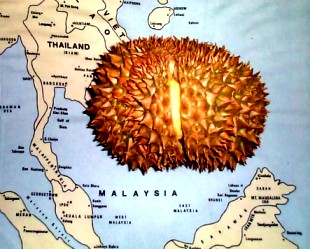 The durian tree is ultra-tropical, a native of Southeast Asian equatorial rainforests, and needs much tropical warmth, abundant moisture, and sunshine to thrive (except for the young trees’ first year, when semi-shade is preferred — simulating rainforest conditions). Most commercial durian cultivation in Southeast Asia is located within 15 degrees latitude of the equator, and some literature has suggested that 18 degrees north or south is the limit at which durians can thrive. However, growers in the Hawaiian Islands have demonstrated that durian cultivation is quite possible as far north as the island of Kaua‘i at 22 degrees north (1 degree latitude equals about 70 miles or 112 km, at these latitudes). And in Thailand, one of the established commercial durian-growing areas is in the northern province of Uttardit, not far from Chiang Mai at 18 degrees north; the southernmost point of land in Hawai`i is only about 70 miles [115 km] further north in latitude than this. Successful durian cultivation is very unlikely outside the tropics.
The durian tree is ultra-tropical, a native of Southeast Asian equatorial rainforests, and needs much tropical warmth, abundant moisture, and sunshine to thrive (except for the young trees’ first year, when semi-shade is preferred — simulating rainforest conditions). Most commercial durian cultivation in Southeast Asia is located within 15 degrees latitude of the equator, and some literature has suggested that 18 degrees north or south is the limit at which durians can thrive. However, growers in the Hawaiian Islands have demonstrated that durian cultivation is quite possible as far north as the island of Kaua‘i at 22 degrees north (1 degree latitude equals about 70 miles or 112 km, at these latitudes). And in Thailand, one of the established commercial durian-growing areas is in the northern province of Uttardit, not far from Chiang Mai at 18 degrees north; the southernmost point of land in Hawai`i is only about 70 miles [115 km] further north in latitude than this. Successful durian cultivation is very unlikely outside the tropics.
Altitude:
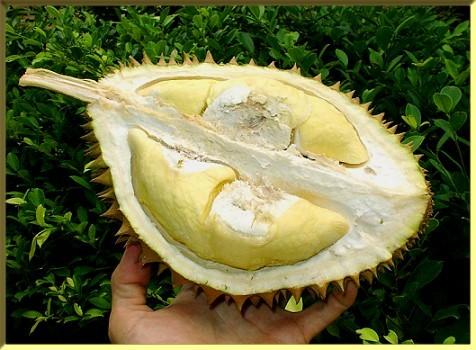 In Sri Lanka, the upper elevation limit for growing durians is said to be 600 m [2000 feet]; in the Philippines, 700 m [2300 feet], in Malaysia, 800 m [2600 feet]. These are the upper limits at which it’s possible to grow durians at all, though, not the optimum; on Penang island in Malaysia, few productive durian farms are above 300 m [700 feet].
In Sri Lanka, the upper elevation limit for growing durians is said to be 600 m [2000 feet]; in the Philippines, 700 m [2300 feet], in Malaysia, 800 m [2600 feet]. These are the upper limits at which it’s possible to grow durians at all, though, not the optimum; on Penang island in Malaysia, few productive durian farms are above 300 m [700 feet].
These places are also all relatively close to the equator, which suggests that the altitude limit for successful durian growing in areas further away from the equator like Hawai‘i may be considerably less, perhaps 300 m [1000 feet] at the most, with best growth and production at the lower elevations. It will take some experimentation by growers at marginal altitudes in more northern or southern tropical areas (such as Hawai‘i) to determine just what is the upper limit for growing durians there.
The Hawaiian islands in particular have so many microclimates depending on elevation, wind patterns, terrain, and existing vegetation that it may be difficult to give any set rules for this. Some higher-elevation microclimates as on the south slopes of gulches, may be suitable though the surrounding area is not.
Regarding altitude and climate, coconuts may be a fairly good indicator as to the likelihood of success with growing durians: if coconut palms can grow and bear well in your micro-climate… except for seaside areas [durians are not salt-tolerant], durians may be possible too.
Temperature:
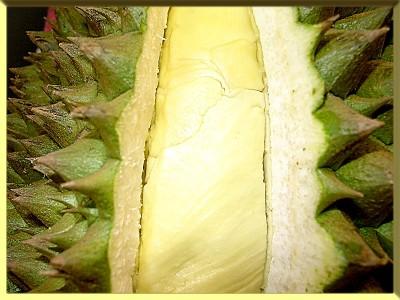 For an ultratropical, durian is surprisingly tolerant of relatively low mean temperatures. There are places on the island of Java between 400-600 m [1300-2000 feet] altitude where durian is successfully grown that have a mean yearly normal temperature of just 23º C. (73º F.) Some research has indicated that growth is limited below a mean monthly temperature of 22º C. [71º F.]. The trees may survive occasional dips in temperature as low as 10º C. [50º F.], but may drop their leaves. On the other end of the spectrum, durian trees in India sometimes successfully tolerate high temperatures up to 46º C. [114º F.].
For an ultratropical, durian is surprisingly tolerant of relatively low mean temperatures. There are places on the island of Java between 400-600 m [1300-2000 feet] altitude where durian is successfully grown that have a mean yearly normal temperature of just 23º C. (73º F.) Some research has indicated that growth is limited below a mean monthly temperature of 22º C. [71º F.]. The trees may survive occasional dips in temperature as low as 10º C. [50º F.], but may drop their leaves. On the other end of the spectrum, durian trees in India sometimes successfully tolerate high temperatures up to 46º C. [114º F.].
Water:
Durian trees need abundant rainfall, or equivalent irrigation. In most areas of Asia where durians are grown, mean annual rainfall is greater than 2000 mm [75 inches]. Historically, though, the better production sites have developed in areas with annual mean rainfall totals of 3000 mm [125 inches] or more, well distributed throughout the year. There is no doubt, though, that drier zones can produce good crops with appropriate irrigation. In India, durian trees are often planted along the banks of streams, where the roots can reach water. They do not do well very close to the ocean, having almost no tolerance for salinity in the soil.
Established durian trees cannot withstand more than 3 months drought without suffering irreversible damage. However, in places fairly close to the equator (such as Malaysia), three to four weeks of dry weather and relatively dry roots are needed to provoke the tree to flowering. Without a sufficient dry period, there will be no fruit that season. Farther from the equator, on the edges of the tropics (as in Hawai`i) where weather patterns start to somewhat resemble the four seasons of the temperate regions, this dry period is not necessarily required, and flowering is influenced more by day length and seasonal temperature.
Soil:
"Rich soil conditions will make the tree grow well and fast. Sometimes four to five-year old trees can start to flower. The secret is in the soil. Organic fertilizer will improve the soil by balancing the pH level. This will produce quantity and quality durians."—Bao Sheng Durian Farmwebsite, Malaysia
Favorable terrain for good durian cultivation ranges from flat to steep. In Chanthaburi province, Thailand, which leads the world in quantity of annual durian production, many durian plantations are on relatively flat land. In contrast, on the island of Penang, which has the reputation for growing the finest connoisseur durians in Malaysia, all the durian farms are on tall hillsides and valleysides, many of them fairly steep. The root system of a durian tree is very sensitive to standing water, and good drainage is essential, which is well taken care of by such sloping situations.
Durian trees grow best in a rich, deep, well-drained sandy clay or clay loam (deep alluvial or loamy soil), high in organic matter, pH range of 6 - 7. Heavy clay soils are not supportive of good durian tree growth and health, as they do not drain well. Seedlings make more vigorous growth when potted into media that is light and sandy rather than high in clay content.
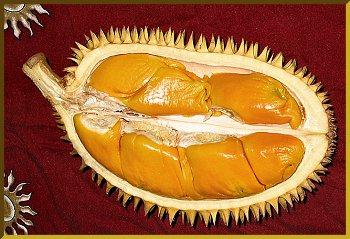 In Thailand it is commonly recommended that growers avoid using organic animal manure, as the most troublesome disease of durian trees there, the fungal Phythophera palmivora, is encouraged by the moist fertile conditions at ground level around the trunk created by manure and mulch. It is not clear that such advice holds true for conditions elsewhere, however, and when using good organic tree planting practices. Traditional organic fertilizers are used with good results in Malaysia and elsewhere.
In Thailand it is commonly recommended that growers avoid using organic animal manure, as the most troublesome disease of durian trees there, the fungal Phythophera palmivora, is encouraged by the moist fertile conditions at ground level around the trunk created by manure and mulch. It is not clear that such advice holds true for conditions elsewhere, however, and when using good organic tree planting practices. Traditional organic fertilizers are used with good results in Malaysia and elsewhere.
In many places in Southeast Asia, semi-wild durian trees thrive and bear perfectly well on their own with relatively little care. Maxing out the health of durian trees of choice varieties with modern organic methods and soil amendments such as compost and rock dust is likely to produce bumper crops of humongous spiky fruits of unimaginable and staggering deliciousness! Amen. :-)
Planting:
In equatorial regions, the most favorable time for planting is winter from November through mid-January (and not during the February-May dry season). In tropical areas far from the equator, early spring is probably best but is likely not too critical.
In Malaysia, planting holes 0.6m [2 feet] in diameter and depth are dug and allowed to weather for 2-4 weeks. (The Brunei Department of Agriculture recommends .5 m deep by 1 meter in diameter.) Organic matter or compost at the rate of about 5-10 kg [10-20 pounds] is added to each hole, also about 200 gm [1/2 pound] of rock phosphate, and the young trees are planted with as little disturbance to the roots as possible. It’s advisable to go further than this, and add rock dust (which enhances a plant’s health and enriches the flavor of the plant’s resulting food harvest) as well as other available organic amendments, and use standard organic tree planting techniques.
In orchards, durian trees are commonly spaced 6-16 m [20 to 50 feet] apart, aiming for about 156 trees/hectare [64 trees/acre] to 40 trees/hectare [16 trees/acre]. T.S. Chang of Bao Sheng Durian Farm in Malaysia recommends 30 trees/hectare [12 trees/acre]. At closer spacings, thinning will be necessary by the time the trees are 8 to 10 years old to reduce tree density and give remaining trees room for further growth. As grafted trees may start bearing at age 4-6, planting the trees more closely in the orchard’s first decade is a way to increase fruit production from a given piece of land. However, T.S. advises against this, saying from experience that few growers who plant more closely can bring themselves to cut down any 10-year old bearing durian trees of good quality to thin out the orchard, and most often allow them to remain. In the long term, this is unfortunate for the trees and the grower, as the trees compete for canopy sunlight in the increasingly cramped situation and eventually grow very tall and thin with less fruitbearing capacity.
It's worth remembering that durian is a native of equatorial rainforests, eventually growing to the high canopy, and is at home amongst a mix of other plants and trees. As the Permaculture approach recommends, other useful plants can be grown among durian trees at ground level and lower levels. These can also provide needed shade during the durian trees' early life, as happens in the rainforest. The Brunei Department of Agriculture recommends interplanting durians with bananas and/or papayas.
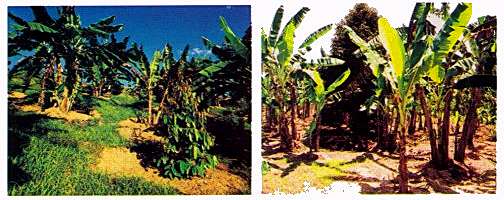
The bananas or papayas should be planted 6 months ahead of the durians, at a spacing of 3 x 3 meters [~10 feet]. Eventually the durians will shade out the bananas or papayas, which can be trimmed and used as mulch and will also of course provide fruit harvest of their own. By the time the durians are fruiting, the banana or papaya plants should be removed, however, as their fruits will draw unwanted pest insects to the area. For trees that will remain interplanted among the durians indefinitely, in Malaysia, rambutan is a favored choice, as is nutmeg and chile pepper plants; but not mangos, mangosteen, citrus, starfruit, jackfruit, champedak, nor many others that can attract pest insects. The Brunei Department of Ag also suggests another alternative of interplanting with fast growing nitrogen-fixing-trees (there are a great many possibilities, including various species of Gliricidia, Sesbania, Leucaena, Albizia, Acacia, and others) which will provide shade, nutritious mulch, and soil improvement.
Propagation:
Propagation of durian trees can be done through either seeds or by vegetative means.
Unlike most seeds of temperate-climate plants, the big seeds of the ultra-tropical durian tree have a very short period of viability out of the fruit, especially if exposed even briefly to sunlight: only a few days at most. (However, if kept in ordinary cool storage, they can be successfully be kept for a week, or as long as a month if surface-sterilized, placed in an airtight container and kept at 20º C. [68º F.]) This high perishability of durian seeds no doubt has been a factor in preventing the durian tree’s widespread dispersal far from its native territories.
The seeds are best planted or sprouted within a day or so from removal from the fruit, sprout end pointed down, to a depth of half the seed with the other half above the soil surface. Healthy durian seeds sprout as quickly and vigorously as bean seeds, usually within a few days but possibly as long as a week. For transport or mailing, the seeds are best immediately placed in moist coconut fiber.
Durian seedlings produce highly variable results. Their fruit may be better or worse than the parent tree, and it may be 10 to even 20 years before first fruit! ("It is reported that, in some countries, seedling durian trees have borne fruit at 5 years of age. In India, generally, they come into bearing 9 to 12 years after planting, but in South India they will not produce fruit until they are 13 to 21 years old. In Malaya, seedlings will bloom in 7 years; grafted trees in 4 years or earlier."—Julia Morton, Fruits of Warm Climates)
Therefore, vegetative propagation, which is not difficult, is universally preferred and recommended for reproducing cultivars with known desirable traits. A large number of grafting methods are commonly employed. In Malaysia, Indonesia and the Philippines wedge (cleft), whip, approach, Forkert, and bud grafting of durian trees are all common. Propagation by airlayers and cuttings does not work. Wedge grafting and bud grafting are probably the most common techniques. Click here to view the Brunei Department of Agriculture's durian-grafting instruction pages.
As reported by the authors of Tropical Tree Fruits for Australia (compiled by P.E. Page, Queensland Department of Primary Industries, Brisbane, 1984), growers in Thailand employ an unusual type of bottle graft with which many or most of their trees are grown. Durian seedlings that will serve as rootstocks are sown in beds and dug up when approximately 300 to 600 mm [1 to 2 feet tall]. The roots are packed with moist coconut husk fiber and sealed in a plastic bag. This rootstock seedling is then tied to a branch of the established durian tree that is desired to be reproduced, next to a lateral branch that appears suitable to serve a scion. The top of the young rootstock plant is then cut off, and the rootstock plant is inarched in a side-veneer graft to the branch/new scion. After the union is complete, the new scion is severed from the mother tree at about the level of the bottom of the seedling roots. The scion butt is also potted up and develops roots, so that the resulting grafted tree actually has two root systems, and is stronger and more vigorous as a result.
Most durian growers regard any variety of durian as suitable for a rootstock as long as it is healthy and vigorous. In Thailand, the common vigorous Chanee variety is said to serve very well as a rootstock. There is also increasing use there of some wild Durio species such as D. malaccensis, D. mansoni, and D. lowianus for resistance to Phythophora palmivora. In India, a relative of the durian, Cullenia excelsa (native to Sri Lanka) is favored as a good vigorous rootstock which is said to also hasten the time of first fruiting.
Management:
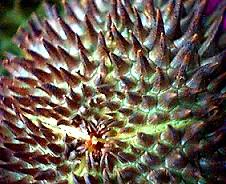 Following planting, young durian trees should be provided with temporary shade and complete wind protection for the first year, as in a shadecloth nursery structure or equivalent. The structure of the young trees and their leaves is such that strong winds can twist the leaves right off, a setback from which they are unlikely to ever fully recover.
Following planting, young durian trees should be provided with temporary shade and complete wind protection for the first year, as in a shadecloth nursery structure or equivalent. The structure of the young trees and their leaves is such that strong winds can twist the leaves right off, a setback from which they are unlikely to ever fully recover.
Proper pruning of the durian tree is said to be important to obtain a tree form that encourages early flowering and good yields. The pruning system commonly used in Southeast Asia includes:
formative pruning resulting in a main leader; after about age 2 or 3 the interior is thinned out, removing all thin or dead branches and water shoots
encouraging early branching to encourage early bearing
topping to maintain a manageable tree height as the tree grows older
general maintenance pruning contributing to a healthy and productive tree, removing dead, broken or diseased branches and water shoots, and allowing free circulation of air and plenty of sunlight throughout the canopy
In Southeast Asia, cut surfaces are routinely treated with a fungicide and bitumastic compound (use an organic equivalent).
Durian growers in Thailand are often advised to keep the area under the tree and drip line area free of weeds, manure, and mulch, primarily so as to not create a microclimate suitable for the thriving of Phythophora palmivora disease. (As previously mentioned, it is not clear if this is necessary or advisable in using strictly organic methods. Durian trees are otherwise benefited from manure and mulch, like many other trees). Likewise, for the same purpose, the trunk of the tree is kept free of any water shoots and weak branches up to a height of about 1 m [3 feet] above the ground. However, tropical legume cover crops between trees, such as perennial peanut, are recommended.
Durian trees are surface feeders, and if any weeding is necessary (with a cover crop like perennial peanut, there shouldn’t be much), care should be taken to prevent damage to the roots.
Durian trees remove a relatively low amount of nutrients from the soil. However, like many other fruit trees, it is a good idea to at least quarterly topdress the soil under the tree with a mix of organic fertilizers (preferably particularly rich in nitrogen and potassium) during the first five years. (Animal manures are favored in most places for this purpose, but not in Thailand, where chemical fertilizers are widely used in commercial production). T.S. Chang of Bao Sheng Durian Farm recommends placing topdressed fertilizer just beyond the edge of the root zone so that the trees’ roots will chase after it and expand their reach in the process. The times a few months before flowering, during fruit development, and after harvesting are favored for fertilizing durian trees throughout Southeast Asia.
Water:
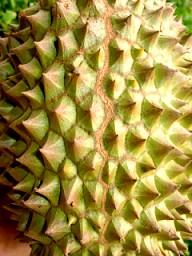 In Asia, areas with a dry season longer than 3 months are regarded as marginal for durian, unless adequately irrigated, in which case there is no problem. Micro-sprinkler or drip irrigation can be used. Durian trees are as incapable of withstanding any standing water around their trunks as papayas; they will simply die. In low-lying rainy areas, it may be advisable to construct surface drainage systems to prevent that possibility from ever occurring, or to plant only on sloped land, as is done in many areas of Southeast Asia.
In Asia, areas with a dry season longer than 3 months are regarded as marginal for durian, unless adequately irrigated, in which case there is no problem. Micro-sprinkler or drip irrigation can be used. Durian trees are as incapable of withstanding any standing water around their trunks as papayas; they will simply die. In low-lying rainy areas, it may be advisable to construct surface drainage systems to prevent that possibility from ever occurring, or to plant only on sloped land, as is done in many areas of Southeast Asia.
The times most critical for water for the durian tree are during flowering and fruiting. In equatorial regions, it needs at least three to four weeks of dry weather without rain to produce flowers to fill all branches. (Farther from the equator as in Hawai`i, this may not hold true, and day length and temperature may be the primary factors in inducing flowering). Like mango trees, heavy rains and wind during flowering can knock off many of the blossoms, decreasing or even eliminating fruit production that season. When blossoms are forming, water is sometimes deliberately withheld to enhance flowering. To maximize flower and fruit production, after allowing a 3 to 4 week dry period, growers in Malaysia then begin applying irrigation. Topdressing the trees with organic fertilizer just before flowering also increases production. Various cultivars may have their own unique responses to dry weather and irrigation; for exam-ple, the common Malaysian cultivar D24 is sensitive even to short dry spells; the common Thai variety Chanee tends to drop flowers if watered as much as other varieties. An unseasonal drought may provoke durian trees to an out-of-season round of flowering and fruiting.
Pests:
As with any plant or tree, the best way to minimize damage of durian trees or fruit by pests or disease is to keep the soil and tree as maximumly healthy as possible using modern organic methods.
Except for usually light damage by local fruit borers, beetles, and leaf cutters in some areas, the tree and fruit tend to be relatively free of insect pests. Phytophthora palmivora is a dreaded fungus disease of durian trees in Southeast Asia. The organism is a primary parasite of durian roots. Symptoms are canker development on the trunk at or just above ground level, and an oozing of brownish-red gum at the collar of the tree, up the trunk and down to the roots, which can result in complete girdling and subsequent death of the tree. The organism gains access to the interior tissues of the tree suitable for its growth through natural or pruning wounds, thus hygienic pruning and using (natural) fungicides are very important to guard against infestation. Grafted trees are said to be particularly susceptible due to cracks that often form in the tree structure due to inherent grafting weaknesses. In Thailand, as previously noted, steps are taken to eliminate a moist microclimate at the base of the tree which might support the growth of P. palmivora, such as not using animal manures or mulch, and removing any branches starting to grow below about 1 m [3 feet] height. Growth of P. palmivora in Southeast Asia is also controlled by using cultivars known to be resistant.
Harvest:
Grafted cultivars generally start bearing at 4 to 6 years after planting in the ground; seedlings usually take from 7 to 10 years but have been known to wait as long as 13 to 21 years—powerful incentives to use vegetative propagation.
Durian fruits vary in size and shape depending on variety and completeness of pollination, but most often are oblong and have an average mass slightly larger than a (U.S.-style) football. Fruit weights of 1.5-4 kg [3 to 10 pounds] are common, but occasionally massive 8 kg [20 pound] (tribal-size!) durians are produced. Of the weight of a typical whole durian, only about 15% to 25% is fruit pulp and about 20% is seeds, making it one of the most expensive fruits in the world in terms of its ratio of whole fruit to the part actually edible.
Depending on variety and climate conditions, it may require from about 85 to 150 days for durians to develop after flower pollination, and if not harvested, they will naturally drop from the tree over about a 10-week period.
In areas near the equator where there are no defined wet and dry seasons, as in parts of Malaysia and Sumatra, individual trees commonly bear fruit twice a year, with the peaks in June and December. In these equatorial areas, durian trees do not start flowering in response to any seasonal changes in day length or temperature, but rather are stimulated to flower by periods of dry weather. In tropical areas with distinct wet and dry seasons, for example, India and eastern Java, flowering begins near the end of the dry season. In tropical areas farther than 10º north or south from the equator, flowering normally starts in the spring months, with an annual harvest in mid-summer to autumn. There is a tendency with some trees to bear only every other year, even in areas where twice-a-year fruiting is possible.
"Initial yield may be 10 to 40 fruits for the first year of fruiting to about 100 fruits for the sixth year. Yield of up to 200 fruits is common after the 10th year of fruiting"
Well-grown, high-yielding cultivars may produce 10 to 15 tons per hectare [9000-13000 pounds per acre] of durian fruits per year by 10 to 15 years after planting. As durians command relatively expensive market prices even in the areas of southeast Asia where they are plentiful, it is easy to understand that in that part of the world, people who have more than a few bearing durian trees are considered wealthy.
The two very different approaches
to harvesting durians
Shunyam Nirav
As inclined to diversity as the durian is, it’s not too surprising that two very different basic approaches to harvesting and eating durians has developed among humans. For convenience they can be called the Thai approach, which is prevalent mostly only in Thailand, and the Malaysian approach, which is prevalent almost everywhere else in Southeast Asia but has been particularly developed and refined in Malaysia.
In Thailand, it’s customary to harvest durians from the tree by cutting with a knife (sometimes on the end of a long pole), when they are approaching ripeness, but not entirely ripe. Like papayas, bananas, and avocados, durians do ripen well off the tree, if not cut too soon. Many people (including me) savor Thai varieties of durians eaten when mid-ripe, somewhat before totally ripe; totally ripe is usually past their peak of deliciousness. The Thai durian varieties have evidently been selected and bred over generations to support this customary harvesting-before-ripe. Part of the fruit stem (botanically speaking, the peduncle) is always left attached when the durian is cut from the tree, rather than breaking off the fruit from the stem. The fruit stem is cut as long as practically possible, and is often wrapped with a banana leaf or paper, which is said to extend the fruit’s shelf life.
In Malaysia (and elsewhere), it’s a fundamental principle that durians should be allowed to naturally fully ripen on the tree for maximum-quality flavor, aroma, texture, and appearance. Durian growers wait until the trees naturally drop their ripe fruit, and collect the fruit several times a day from under the trees. To prevent damage from hitting the ground or rocks (or people!), either large safety nets are arranged under the trees to catch the falling spiky fruits; or workers climb the trees early in the season to attach long strings or ropes to each developing fruit, which are looped over branches above and then down to ground level like a pulley, so when the fruits are dropped by the tree they are caught and can be safely and easily lowered. Durians in Malaysia are thus regarded as highly perishable commodities — those that have fallen within the past 12 hours command very high prices in the marketplaces; after 12 hours the quality is perceived as having diminished and become ordinary, and the price is reduced. On Penang, at Bao Sheng farm, the best just-dropped varieties of durians sold in the 1999 season for about the equivalent of US$3.50 a pound, which meant that a typical 4-pound durian cost about US$15 for one fruit. That’s at the farm, though; just-dropped durians are rushed from farms to the cities of Malaysia where the same durian may readily sell for over twice the farm price. And in durian-crazed Singapore, when swiftly exported fresh-dropped Malaysian durians of the highest quality varieties are available there, durian connoisseurs snap them up for the equivalent of US$75 per fruit! For the lowest prices and good fun, large numbers of Malaysian durian-lovers make pilgrimages to durian farms in various regions of the country during the season to savor the best freshly-dropped durians. It’s a real connoisseur scene in Malaysia around durians — over a hundred officially registered varieties (and countless more unregistered), all with rich subtle differences of flavor, texture, aroma, and appearance, and much importance given to tree-ripening and fresh-droppedness. Malaysian varieties are generally smaller than Thai durians (rarely as large as a soccer ball), many varieties have much thinner spikes, and usually the fruit flesh around the seeds is not as thick as is common in Thai varieties. They usually have a much more complex and rich flavor than most Thai durians have, though, and it can be highly variable from fruit to fruit from the same tree, even from section to section within the same fruit.
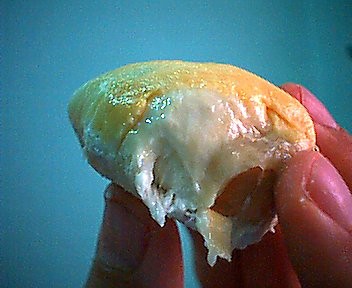 It’s evident that Thais and Malaysians have a good-natured rivalry around their approaches to durians. The Malaysians disapprove of the Thai practice of harvesting durians before ripe and letting them ripen off the tree — that’s unthinkable in Malaysia. To cut durians early and not allow them to ripen on the tree and drop naturally occurs to most Malaysians as an insensitive ruination of full-flavored durian quality. (T.S. Chang of Bao Sheng Durian Farm asserts that durians lose 20% to 25% of their full potential for aroma and flavor by being harvested early...and I can understand from eating Malaysian durians what he means.) However, a Thai variety of durian allowed to ripen and drop from the tree is usually already past its prime. The Thais possess durian varieties which in their own way are of magnificent quality when cut, ripened off the tree (like bananas), and eaten at just the right stage before totally ripe. Having the kinds of durian varieties they have, Thais don’t understand Malaysians’ (and others) obsession with tree-ripened fruit and enduring all the harvesting and marketing challenges and high prices that result. The practically-inclined Thais do have a commercial advantage with their approach — cutting durians before ripe has allowed them to develop a large profitable commercial durian-growing industry, the biggest of any country. In Thailand, everyone has about a week after harvesting to transport and market the fruit far and wide, whereas the Malaysian practice of only accepting tree-ripened durians necessarily greatly limits their commercial reach and shelf life and makes them very costly to consumers. Malaysians, however, cheerfully just regard these things as facts of life that necessarily come with obtaining their high-quality tree-ripened durians, satisfied that their durians have a much richer and more complex flavor and better overall quality than those of their Thai neighbors.
It’s evident that Thais and Malaysians have a good-natured rivalry around their approaches to durians. The Malaysians disapprove of the Thai practice of harvesting durians before ripe and letting them ripen off the tree — that’s unthinkable in Malaysia. To cut durians early and not allow them to ripen on the tree and drop naturally occurs to most Malaysians as an insensitive ruination of full-flavored durian quality. (T.S. Chang of Bao Sheng Durian Farm asserts that durians lose 20% to 25% of their full potential for aroma and flavor by being harvested early...and I can understand from eating Malaysian durians what he means.) However, a Thai variety of durian allowed to ripen and drop from the tree is usually already past its prime. The Thais possess durian varieties which in their own way are of magnificent quality when cut, ripened off the tree (like bananas), and eaten at just the right stage before totally ripe. Having the kinds of durian varieties they have, Thais don’t understand Malaysians’ (and others) obsession with tree-ripened fruit and enduring all the harvesting and marketing challenges and high prices that result. The practically-inclined Thais do have a commercial advantage with their approach — cutting durians before ripe has allowed them to develop a large profitable commercial durian-growing industry, the biggest of any country. In Thailand, everyone has about a week after harvesting to transport and market the fruit far and wide, whereas the Malaysian practice of only accepting tree-ripened durians necessarily greatly limits their commercial reach and shelf life and makes them very costly to consumers. Malaysians, however, cheerfully just regard these things as facts of life that necessarily come with obtaining their high-quality tree-ripened durians, satisfied that their durians have a much richer and more complex flavor and better overall quality than those of their Thai neighbors.
When I visited both countries in June 1999 at the peak of durian season, the highest-quality durians in Thailand were selling in the marketplaces for the equivalent in U.S. money of about 50 cents a pound; over the border in Malaysia highest-quality durians were selling for the equivalent of US$3.50 a pound at the farm, more in the marketplaces. Durians in Thailand have been made a widespread commodity that the majority of average people appear to be able to afford; in Malaysia it appears that durians are in financial reach of primarily only wealthier consumers (not a criticism, just an observation of the way things are). However, the big exceptions in either country are people who grow their own durians...who, if they have more than a few trees, inevitably become wealthy themselves from the abundant bounty given year after year by the trees!
 As a durian-lover from the outside, I respect, understand, and enjoy both the Thai and Malaysian approaches and the resulting fruit. I’ve been fortunate to experience both incredibly luscious Thai durians (especially Monthong and especially those grown on the southern islands of Koh Samui and Koh Pha-Ngan, and in the durian-growing capital of Chanthaburi in eastern Thailand) — and some of the extremely richly-delicately-flavored connoisseur creme-de-la-creme Malaysian durians (especially on the island of Penang). Comparing them isn’t really fair; at their best they’re both fantastic, unmistakably durian and yet so different — as similar and yet as different as, say, Chinese and Japanese humans. And then there are all the other durian varieties found in Indonesia, Brunei, the Philippines, Vietnam, south India, and Sri Lanka, with a vast range of subtle differences and nuances. If you enjoy eating durian and get a chance to be in that part of the world during the season, visit the colorful local marketplaces and try as many as you can! Or better yet, if you live in a tropical area, seek out the best varieties of grafted trees to grow yourself!
As a durian-lover from the outside, I respect, understand, and enjoy both the Thai and Malaysian approaches and the resulting fruit. I’ve been fortunate to experience both incredibly luscious Thai durians (especially Monthong and especially those grown on the southern islands of Koh Samui and Koh Pha-Ngan, and in the durian-growing capital of Chanthaburi in eastern Thailand) — and some of the extremely richly-delicately-flavored connoisseur creme-de-la-creme Malaysian durians (especially on the island of Penang). Comparing them isn’t really fair; at their best they’re both fantastic, unmistakably durian and yet so different — as similar and yet as different as, say, Chinese and Japanese humans. And then there are all the other durian varieties found in Indonesia, Brunei, the Philippines, Vietnam, south India, and Sri Lanka, with a vast range of subtle differences and nuances. If you enjoy eating durian and get a chance to be in that part of the world during the season, visit the colorful local marketplaces and try as many as you can! Or better yet, if you live in a tropical area, seek out the best varieties of grafted trees to grow yourself!
More cultivation information: Durian chapter (19 pages) from The Production of Economic Fruits in South-East Asia by Othman Yaacob and Suranant Subhadrabandhu (Oxford University Press, New York, 1995).